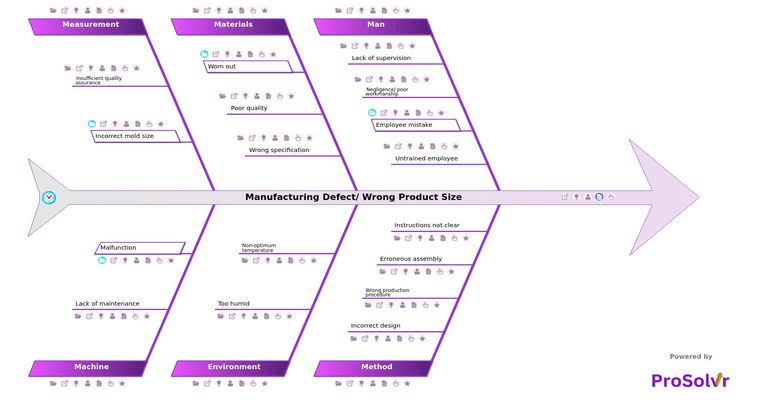Root Cause Analysis for Minimizing Manufacturing Defects
Efficiently managing manufacturing defects is crucial for maintaining high product quality and customer satisfaction. By leveraging advanced AI-driven root cause analysis (RCA) tools like those offered by ProSolvr, teams can systematically identify and address the underlying causes of production defects. This streamlined approach aligns with Six Sigma methodologies, ensuring defects are minimized and overall product quality is maximized through effective Corrective and Preventive Actions (CAPA).
ProSolvr's AI-driven RCA tool simplifies the complex process of troubleshooting. It enables comprehensive visual analysis, facilitating quicker issue detection and collaborative problem-solving among team members. This not only enhances team efficiency but also fosters a culture of continuous improvement, crucial for resolving recurring issues and preventing future problems. Integrating ProSolvr into operations optimizes every production process step for enhanced quality and reliability.
Designed to support Six Sigma initiatives, ProSolvr provides a robust platform for continuous improvement by enabling proactive problem-solving through the tracking and analysis of production data. The AI-driven RCA facilitates swift implementation of CAPA measures, effectively mitigating risks and enhancing operational excellence. This proactive approach results in fewer defects, higher product quality, and increased customer satisfaction, bolstering organizational competitiveness in the marketplace.
Effective defect resolution in manufacturing necessitates precise identification and understanding of root causes. ProSolvr's visual RCA tool empowers teams to achieve this with ease, emphasizing quality and reliability to foster operational excellence. Enhanced team collaboration and efficiency lie at the heart of ProSolvr's solution, ensuring all team members contribute effectively to issue resolution.
In conclusion, ProSolvr's AI-driven RCA tools are indispensable for manufacturing teams committed to achieving operational excellence and superior product quality. By integrating visual RCA capabilities and supporting Six Sigma methodologies, ProSolvr enhances team efficiency and collaboration, driving continuous improvement across production processes. Choose ProSolvr for its superior problem-solving capabilities and steadfast commitment to quality and reliability, ensuring optimized production processes and consistent delivery of high-quality products.
In minimizing manufacturing defects, addressing issues such as supervision gaps, procedural errors, and material deficiencies is crucial for optimizing operational efficiency and product quality. Implementing these insights not only mitigates risks but also fosters a culture of continuous improvement, ensuring compliance with regulatory standards and enhancing overall safety and reliability in manufacturing processes. This structured approach equips organizations to sustain success, meet customer expectations, and uphold a commitment to operational excellence.
Who should use the Manufacturing Defects template?
The Manufacturing Defects template is designed for various stakeholders involved in manufacturing processes, including:
- Manufacturing Managers and Engineers: Utilize the template to systematically analyze and address root causes of defects, improving production efficiency and product quality.
- Quality Assurance and Control Teams: Use it to identify recurring issues and implement corrective actions to maintain high standards and reduce defects.
- Operations and Production Teams: Enhance process efficiency, reduce downtime, and minimize defects in manufacturing operations.
- Safety and Compliance Officers: Ensure manufacturing processes comply with safety standards and regulatory requirements, mitigating risks associated with defects.
- Continuous Improvement Teams: Foster a culture of innovation and efficiency within manufacturing environments.
- Executive and Management Teams: Make informed decisions about resource allocation, process improvements, and strategic direction in manufacturing operations.
Overall, the Manufacturing Defects template serves as a structured tool to help organizations in the manufacturing industry enhance quality, efficiency, compliance, and operational excellence.
Why use the Manufacturing Defects template?
The Manufacturing Defects template provides a structured approach for addressing and minimizing defects in manufacturing processes. Here’s why it’s beneficial:
- Systematic Analysis: Helps systematically analyze root causes of defects, enabling targeted corrective actions.
- Improved Quality: By addressing defects, it enhances product quality and customer satisfaction.
- Efficiency Gains: Reduces downtime and waste, optimizing production efficiency.
- Compliance Assurance: Ensures compliance with regulatory standards and industry requirements.
- Risk Mitigation: Identifies and mitigates risks associated with defects, improving overall operational reliability.
- Continuous Improvement: Supports a culture of continuous improvement by fostering proactive defect prevention.
- Data-Driven Decisions: Provides insights based on data analysis, facilitating informed decision-making in manufacturing processes.
Whether you’re a manufacturing manager, quality assurance professional, or involved in operations, using the Manufacturing Defects template can streamline defect management and contribute to overall operational excellence.








